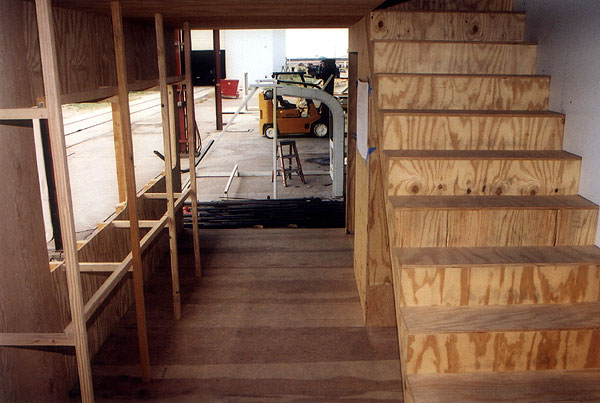This website has been archived from TrainWeb.org/ultradomes to TrainWeb.US/ultradomes.
|
Another tour of the Colorado Railcar shop Pure pleasure took me back to Colorado in August, 2004. After flying into Denver International Airport, I couldn't resist taking a quick side trip (sure, it's in the opposite direction) to Ft. Lupton before heading down to Durango. Colorado Railcar VP of Sales Tom Janaky took time out from his day to guide me around the shop again and patiently field my questions. While I had some specific projects in mind to get shots of, I learned a lot more about the manufacturing process, which I wanted to share.
The cars sitting outside the shop had been rearranged somewhat. Anticipated increases in business have forced Colorado Railcar to rethink its shop space. Mr. Janaky mentioned that an expansion was in the works. Here we see the three ex-Marlboro Unlimited cars, which are now east of the main plant. They are, from left to right, SC-1, LC-2 and SC-2. The first two are used as spatial concept cars to illustrate certain ideas. I toured those cars and created a separate section for them last year.
To streamline production and reduce the amount of expensive equipment needed, all of the steel used in Colorado Railcar's manufacturing comes pre-shaped. Here we see a stack of steel dome bows. The halves will be mated up and welded together to form the upper supports of the dome section of the cars.
A set of the bows after being welded together. The substantially larger bow that Mr. Janaky is showing off is one of the end braces, which are much thicker and stronger because they also act as the collision posts to allow Colorado Railcar's products to meet current FRA safety standards.
Tom told a rather amusing story about CRM's on-site paint booth. When built, the tallest product being built was the 18 foot, 1 inch tall dual level domes. But the double decker DMU and coach will sit a whopping 19 feet 6 inches off of the rail. And it turned out that the paint booth was just a tad too short. So while the cars were taking shape on the construction floor, work was being done to raise the roof of the paint booth to match. The extension is clearly seen as the vertical section above the beveled corner. While we were there, contractors were measuring the booth for new doors.
Though these photos are used in the tour of the new Florida DOT DMUs, I think they are important enough to bear repeating. Mr. Janaky used the term "spatial concept" several times, and here's a good example of what he meant. The proof is in the pudding - or in this case, a full size mock up of one entrance, the lower level with windows, stairs, and the upper level of the double Decker DMU. Before committing it to more expensive sheet metal, several key measurements needed to be tested. Much more effective to make mistakes before it takes a welder to fix them.
Talk about your models. This 1:1 scale job was intended mainly to prove one point: that the headroom would be sufficient at the top of the stairs. If you think about it, the double deckers are the first cars built by CRM with straight staircases. The more elegant spiral staircases that the luxury domes have would be out out place on a car where moving volumes of people in and out in a hurry is a priority. So the concept had to be tested. As Mr. Janaky put it (and I'm paraphrasing) "you can make lines on paper and have it look good, but nothing beats actually trying it in three dimensions." In keeping, this mock up was built to exact specifications (that's the DMU's plans taped to the wall) so people could come outside and walk up and down it. And if even one change was made as a result of this test, then it more than paid for itself. And even if it was perfect the first time around, a little peace of mind goes a long way.
As we've mentioned in the manufacturing overview, the actual car layup takes about two weeks of the nine month building process. The rest of it all is finish work. Lots of finish work. Some of that is outsourced, but to cut down on costs a lot of the work is done in house. Including cabinet making. Full-scale mock ups aren't the only wood working going on at CRM. Attached to the main shop is a well-equipped wood shop, where I found this gentleman doing some work for one of the cars under construction inside. My apologies to the photographed, but I didn't get his name or any details about what project he was working on, as I felt I was disturbing him too much as it was. Having Tom Janaky as a tour guide sure enhanced the visit as a whole. The people at Colorado Railcar seem to be proud of their work, and Mr. Janaky's enthusiasm for the cars and specifically the DMU shows through as well. I hope that you've enjoyed seeing some of the extra things I picked up during my visit. Follow this link to see an earlier tour of the shop, taken in November, 2003. Use the back button on your browser to return to the car roster page that you came from. |
Return to the home page
Roster
/ History / Ultra
Domes / Single Level / Commuter
Operators
/ Photos & Features / News
& Updates / Links





















